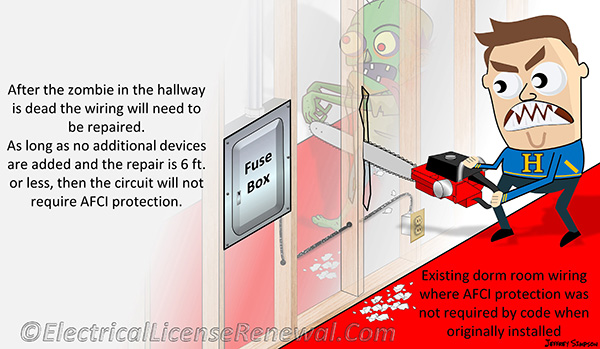210.12(D) AFCI Protection. Branch Circuit Extensions or Modifications - Dwelling Units and Dormitory Units.

Click to Enlarge
An exception allows a branch circuit extension up to a 6 ft. to remain without the need to install AFCI protection, as long as no additional outlets or devices are installed.
Code Change Summary: Revised code language now requires AFCI protection when modifying or extending specific circuits in a dormitory room.
In the 2011 NEC®, the following rules were put in place to require AFCI protection for extended or modified branch circuits in dwelling units:
“In any of the areas specified in 210.12(A), where branch-circuit wiring is modified, replaced, or extended, the branch circuit shall be protected by one of the following:
(1) A listed combination-type AFCI located at the origin of the branch circuit.
(2) A listed outlet branch-circuit type AFCI located at the first receptacle outlet of the existing branch circuit”.
In the 2017 NEC®, the above rules were expanded to include any modified or extended 120-volt branch circuit wiring in dorm rooms.
This applies even in older dorm rooms that were built long before AFCI protection first appeared in the code book.
In a dormitory room, AFCI protection is required for 120-volt, single-phase, 15- or 20-ampere branch circuits supplying outlets and devices installed in dormitory bedrooms, living rooms, hallways, closets, bathrooms, and similar rooms.
An exception allows a branch circuit extension up to a 6 ft. to remain without the need to install AFCI protection, as long as no additional outlets or devices are installed. This gives a bit of relief for older homes and dorm rooms where a fuse box is replaced with a newer panelboard. As long as branch circuits are not extended more than 6 ft. to make terminations on the new circuit breakers, AFCI protection is not required.
Below is a preview of Article 210. See the actual NEC® text at NFPA.ORG for the complete code section. Once there, click on their link to free access to the 2017 NEC® edition of NFPA 70.
2014 Code Language:
210.12(B) Branch Circuit Extensions or Modifications — Dwelling Units. In any of the areas specified in 210.12(A), where branch-circuit wiring is modified, replaced, or extended, the branch circuit shall be protected by one of the following:
(1) A listed combination-type AFCI located at the origin of the branch circuit.
(2) A listed outlet branch-circuit type AFCI located at the first receptacle outlet of the existing branch circuit.
Exception: AFCI protection shall not be required where the extension of the existing conductors is not more than 1.8 m (6 ft) and does not include any additional outlets or devices.
2017 Code Language:
210.12(D) Branch Circuit Extensions or Modifications — Dwelling Units and Dormitory Units. In any of the areas specified in 210.12(A) or (B), where branch-circuit wiring is modified, replaced, or extended, the branch circuit shall be protected by one of the following:
(1) A listed combination-type AFCI located at the origin of the branch circuit.
(2) A listed outlet branch-circuit type AFCI located at the first receptacle outlet of the existing branch circuit.
Exception: AFCI protection shall not be required where the extension of the existing conductors is not more than 1.8 m (6 ft) and does not include any additional outlets or devices.
Did You Like This? Let Us Know With A Like! Thanks!
210.12(D) AFCI Protection. Branch Circuit Extensions or Modifications - Dwelling Units and Dormitory Units.
Below is a Real Question from our Electrical Continuing Education Courses for Electrical License Renewal:
Which of the following is true when extending an existing branch circuit in the bedroom of a dormitory built long before AFCI was ever required?
Answered: None Yet!
Score: None Yet!
ElectricalLicenseRenewal.com Recommends:
